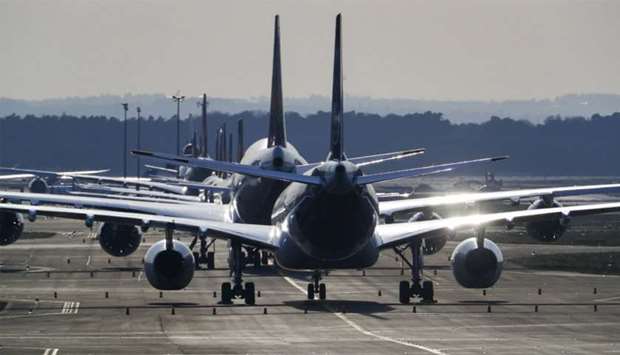The coronavirus pandemic is taking a massive toll on nations around the world. It is affecting everyone, including businesses of all hues. Perhaps, the hardest hit is the travel industry — and specifically, the airlines.
With coronavirus biting the global economy and aviation industry very hard, airlines are grappling with a new and huge problem—where to park the thousands of aircraft that idle because of no passengers.
Taxiways, maintenance hangars and even runways at many major airports have been transformed into giant parking lots for more than 2,500 airliners, the biggest of which takes up about as much room as an eight-story building with a footprint 3/4 the size of an American football field.
Nearly 98% of revenue-earning routes across the world are now subject to “severe” travel restrictions, including border closures, partial travel bans, and quarantine measures, according to the International Air Transport Association (IATA).
In Europe, seat capacity is forecast to be slashed 90% in the second quarter of 2020. Capacity in the Middle East is expected to tumble 80%, while the United States and Asia will see 50% drops, IATA’s latest figures show.
More than 10,500 aircraft, representing 40% of the global fleet, have been grounded already and that number is only likely to increase.
With the unprecedented number of aircraft grounded globally, the question is where to put them. Naturally enough, airlines are trying to keep the grounded planes close to home.
Taxiways, maintenance areas, terminal areas, and in some cases even runways, are being used at airports throughout the world.
“Airlines want to keep their aircraft as close as they can to their hub airports because they can maintain them and get them back into the air relatively quickly,” says Sergio Fernandez, IATA’s Europe regional director of Airport, Passenger, Cargo and Security.
With demand for air travel in a nosedive, US airlines are taking hundreds of commercial planes out of service and parking them in remote desert airports, with the hope that the aircraft will be back in the air shortly, Los Angeles Times reported recently.
The coronavirus outbreak has pushed so many planes out of service that the business of storing aircraft is taking off, with some remote airports parking more and more planes on seldom-used runways and taxiways, the newspaper said.
At any given time during the pre-coronavirus era – there were usually as many as 20,000 planes swirling around the planet at high altitudes. The system isn't designed for that amount of planes to be anywhere else apart from in the air – the only place they generate revenue, according to CNN.
“Parking at airports is also pricey. Major European hubs can charge in the region of $285 an hour,” the media outlet says.
The logistical complexities of where to park thousands of airplanes is made even more complicated by the technicalities required when storing planes.
To ensure they are stored in a way that enables them to return to service in tip-top condition when flights eventually resume, a kind of “aeronautical embalming” process is required.
This involves draining various fluids, covering the engine intakes and exhaust areas, protecting external instruments like pitot tubes (used for monitoring the airplane's speed during flight), covering windows and tires -- along with other tasks specific to each plane, CNN noted.
Once the decision has been made to ground an aircraft, a lot remains to be done, IATA points out. Much depends on how long the plane is likely to be grounded – from a couple of days where very little maintenance is needed to a couple of months and longer where preservation of the aircraft becomes necessary.
Cabins must be cleaned before being sealed for security, fuel tanks and oil lines drained – and perhaps replaced with other liquids – and exposed chrome surfaces including in the undercarriage have to be protected from corrosion.
The preservation process varies depending on the length of time that the aircraft is likely to be out of service.
And then there is weekly maintenance if the plane is grounded for one or two months: regular checks and testing of avionics, hydraulics and other operating systems, and keeping the cabin sanitised and dry. Manufacturers provide maintenance manuals on exactly what needs to be done and when.
In some cases, engines must be rotated to ease pressure on bearings, and the wheels moved to protect the tires.
Parking costs must also be considered. Some airports, including London’s Heathrow and Charles de Gaulle Paris, are waiving fees but many others are not.
IATA has already written to transport ministers around the world requesting that airports help cash-strapped airlines by cutting parking fees.
Aircraft parking charges account for less than 2% of airport revenues in a normal year, but it could be the make-or-break for some airlines under the current circumstances, analysts say.
And the sooner airlines can recover, the sooner airports will as well.
These are unusual times; the whole world has its eyes fixed on breaking the back of one common enemy- the coronavirus.
Aircraft wheels may be down now, but they will keep their wings up, once we all get ready to embark on our journeys, and explore our beautiful world.
*Pratap John is Business Editor at Gulf Times. Twitter handle: @PratapJohn.




